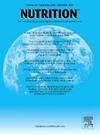Phase angle and vector analysis in the evaluation of body composition in sarcopenic obesity: a systematic review
IF 3
3区 医学
Q2 NUTRITION & DIETETICS
引用次数: 0
Abstract
Background
Sarcopenic obesity (SO) is a condition characterized by low muscle mass and strength and high adiposity. Bioelectrical impedance analysis (BIA) derived phase angle (PhA) and bioelectrical impedance vector analysis (BIVA) are simple and inexpensive tools for the evaluation of body composition, with an emerging consensus in health research and application.
Aim
The aim of this systematic review was to analyze research on sarcopenic obesity using PhA or BIVA.
Methods
A bibliographic search was performed on 13 January 2025, using three databases: PubMed, Scopus and Web of Science. The search terms were: ("phase angle" OR BIVA) and (sarcopenic OR sarcopenia OR obesity). Studies addressing only obesity or sarcopenia were excluded. The quality of the studies was evaluated using the Quality Assessment Tool for Observational Cohort and Cross-Sectional Studies, from the National Institute of Health. No meta-analysis was conducted.
Results
Nine studies were selected, mostly published in 2022 (89%) or later and focused on clinical applications (55.6%). The reviewed studies showed substantial methodological variability. Diagnostic criteria included the ESPEN–EASO algorithm as well as protocols based on different definitions of sarcopenia and obesity. Indices and cut-offs used to define body composition varied accordingly. Variability was also observed in population samples and in bioimpedance devices. All selected studies used PhA and two of them used BIVA. Although quantitative results are variable, with PhA values ranging from 3.9° to 7.1°, and mostly below 5.6°. The qualitative pattern of bioelectrical characteristics associated with body composition in SO is broadly consistent across studies: PhA is tendentially lower than in healthy subjects and patients with obesity and similar to those with sarcopenia; the specific vector is longer.
Conclusions
Research is still quite heterogeneous in terms of methods and diagnostic procedures, which limits the comparability of the results. However, the observed tendencies confirm the suitability of PhA for recognizing the reduced muscle mass associated with sarcopenia, while specific BIVA also appears capable of detecting excess fat mass related to obesity. Further research is needed to standardize procedures for characterizing sarcopenic obesity and monitoring its progression.
相位角和矢量分析在评估肌肉减少型肥胖患者身体成分中的应用:系统综述。
背景:肌少性肥胖(SO)是一种以低肌肉质量和力量和高脂肪为特征的疾病。生物电阻抗分析(BIA)、衍生相角分析(PhA)和生物电阻抗矢量分析(BIVA)是评价人体成分的简单、廉价的工具,在健康研究和应用中逐渐成为共识。目的:本系统综述的目的是分析使用PhA或BIVA治疗肌肉减少型肥胖的研究。方法:于2025年1月13日使用PubMed、Scopus和Web of Science三个数据库进行文献检索。检索词为:(“相角”或BIVA)和(肌肉减少症或肌肉减少症或肥胖)。仅针对肥胖或肌肉减少症的研究被排除在外。使用美国国立卫生研究院的观察性队列和横断面研究质量评估工具对研究的质量进行评估。未进行meta分析。结果:入选9篇研究,大部分发表于2022年(89%)及之后,主要集中于临床应用(55.6%)。回顾的研究显示了大量的方法差异。诊断标准包括ESPEN-EASO算法以及基于肌肉减少症和肥胖不同定义的方案。用来定义身体成分的指数和截止值也相应变化。在人群样本和生物阻抗装置中也观察到可变性。所有选定的研究都使用PhA,其中两个使用BIVA。虽然定量结果是可变的,但PhA值在3.9°至7.1°之间,大多数低于5.6°。在所有的研究中,SO中与身体成分相关的生物电特性的定性模式是广泛一致的:PhA倾向于低于健康受试者和肥胖患者,与肌肉减少症患者相似;特定向量更长。结论:目前的研究在方法和诊断程序上仍存在较大的异质性,限制了结果的可比性。然而,观察到的趋势证实了PhA在识别与肌肉减少症相关的肌肉量减少方面的适用性,而特异性BIVA似乎也能够检测与肥胖相关的多余脂肪量。需要进一步的研究来规范肌肉减少性肥胖的特征和监测其进展的程序。
本文章由计算机程序翻译,如有差异,请以英文原文为准。
求助全文
约1分钟内获得全文
求助全文
来源期刊

Nutrition
医学-营养学
CiteScore
7.80
自引率
2.30%
发文量
300
审稿时长
60 days
期刊介绍:
Nutrition has an open access mirror journal Nutrition: X, sharing the same aims and scope, editorial team, submission system and rigorous peer review.
Founded by Michael M. Meguid in the early 1980''s, Nutrition presents advances in nutrition research and science, informs its readers on new and advancing technologies and data in clinical nutrition practice, encourages the application of outcomes research and meta-analyses to problems in patient-related nutrition; and seeks to help clarify and set the research, policy and practice agenda for nutrition science to enhance human well-being in the years ahead.
 求助内容:
求助内容: 应助结果提醒方式:
应助结果提醒方式:


